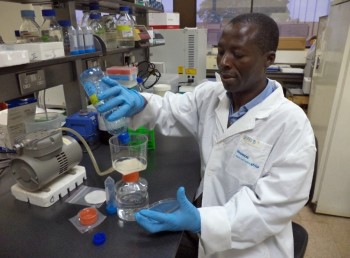This research project aims at improving food fish production by identifying the Clarias species of the Lake Victoria basin, for possible use in artificial propagation at hatcheries and to contribute to improved conservation of clariid catfish resources by determining and describing genetic diversity indices of the species and populations. This three year project is a collaboration between the University of Eldoret and Biosciences Eastern and Central Africa-International Livestock Research Institute whose Principal Investigator is Dr. James Barasa. The other team members include: Francesca Stomeo, Roger Pelle, Emily Chemoiwa, Martina Kyallo, and Jean-Baka D. Entfellner.
Clariid catfishes are a diverse group of fishes endemic to Africa. The genus Clarias has many species spread in different habitats, including lakes, rivers, streams, swamps, and reservoirs. The African catfish, Clarias gariepinus, is the main farmed Clariid catfish species in Africa, where it competes with tilapias as the species preferred by farmers in different countries. Unlike tilapias, farmed C. gariepinus grows fast, has higher fecundity, higher meat content and thrives on a wide range of diets, attributes that contribute to profitable aquaculture ventures. However, C. gariepinus has poor survival at larval stages, and this limits availability of adequate and quality seeds to support expanded culture of the species. Recent research efforts to address this challenge have focused on genetic characterization of populations of C. gariepinus to identify any with attributes suitable for use as better sources of broodstock at hatcheries. An alternative strategy would be to use a different species of Clarias, whose larvae may have higher survival rates. Many small-sized Clarias species exist in the Lake Victoria basin, and could form such suitable candidates. However, their identity is uncertain, because of identification has relied mostly on morphological keys that are less powerful tools. This project used DNA Barcoding techniques to identify small-sized catfishes of Lake Victoria basin, Kenya, to improve their sustainable utilization.
The project is funded by University of Eldoret Annual Research Fund and Biosciences Eastern and Central Africa-International Livestock Research Institute (BecA-ILRI Hub). Some of the key Findings include Identification of 3 different species of Clarias (catfishes) in the Lake Victoria basin of Kenya, in addition to the common African catfish Clarias gariepinus. These include Clarias liocephalus, C. alluaudi, and Xenoclarias, distributed in different sites of Lake Victoria, Lake Kanyaboli, the University of Eldoret reservoir and several rivers draining into Lake Vitoria. Key beneficiaries to the project findings include Fish farmers, Fish hatchery operators, Fisheries Resources managers, researchers, and the scientific managers.
Dr Barasa’s research interest focuses on genetic identification and profiling of Clariid catfishes of Kenya, using different molecular tools, to support improved breeding and sustainable utilization. Results from these studies have been disseminated to the Scientific community and associated stakeholders through publications and by presentation at different Scientific conferences, both regional and international levels. Some of the recent research activities he has carried out include:
- Genetic diversity and Population structure of riverine smooth head catfish, Clarias liocephalus (Boulenger 1898) of Lake Victoria basin, Kenya.
- Multilocus heterozygosity-fitness correlations as a tool for Broodstock choice for improved Clarias gariepinus aquaculture in Kenya
- How many Clariid catfish species inhabit Lake Victoria basin today? Insights from Molecular and morphological analyses.
- Higher genetic diversity in Lake Kanyaboli than Lake Victoria Clarias liocephalus: evidence from mitochondrial DNA sequences.
To further his research, Dr. Barasa in collaboration with Prof. Phillip Raburu as the Co-PI’s won a National competitive Institutional Infrastructure Support Programme by the National Research Fund (NRF) in 2018 to develop a Fish Genetics and Genomics Research and Training Laboratory. The laboratory will provide requisite and modern infrastructure to support research and training in the area of Genomics in agricultural, environmental, health and Natural resource management in Kenya and the region. The research facility which is in its final stages of establishment, will serve both staff and graduate students of the University of Eldoret, as well as other Institutions in the Western Kenya. Apart from providing the equipment for molecular experimental work, the laboratory will also feature a Bioinformatics Platform, to support statistical analyses and computations, especially for large datasets from Next Generation Sequencing platforms.
The recent publications by Dr. Barasa include:
- Alal, G. W., Barasa, J. E., Chemoiwa, E. J., Kaunda-Arara, B., Akoll, P. and Masembe, C. (2021). Genetic diversity and Population structure of selected lacustrine and riverine populations of African catfish, Clarias gariepinus in Kenya. Journal of Applied Ichthyology, 37: 427-438. https://doi.org/10.1111/j.1558- 5646.1965.tb017 31.x
- Svardal, H. et al., (2020). Evolutionary genomics at the Environment-Human interface in Africa. A perspective. Molecular Biology and Evolution, 132: 1-5.
- J. E. Barasa, S. Mdyogolo, R. Abila, P.J. Grobler, M. N. Njahira, R. A. Skilton, Chemoiwa, E. J.,O. G. Dangasuk, B. Kaunda-Arara and E. Verheyen. (2017). Genetic diversity and Population structure of African catfish, Clarias gariepinus in Kenya: Implications for aquaculture and conservation. Belgian Journal of Zoology, 142 (3): 105-127. https://doi.org/10.26496/bjz.2017.9
- J. E. Barasa, R. Abila, P.J. Grobler, M. Agaba, E. J. Chemoiwa, and B. Kaunda-Arara (2016). High genetic diversity and Population differentiation in Clarias gariepinus of Yala swamp: evidence from mitochondrial DNA sequences. Journal of Fish Biology, 89 (6): 2557-2570. https://doi.org/10.1111/jfb.13150
- J. E. Barasa, R. Abila, P.J. Grobler, O.G. Dangasuk, M.N. Njahira and B. Kaunda-Arara (2014). Genetic diversity and gene flow in Clarias gariepinus from Lakes Victoria and Kanyaboli. African Journal of Aquatic Science, 39 (3): 287-293. http://dx.doi.org/10.2989/16085914.2014.933734

